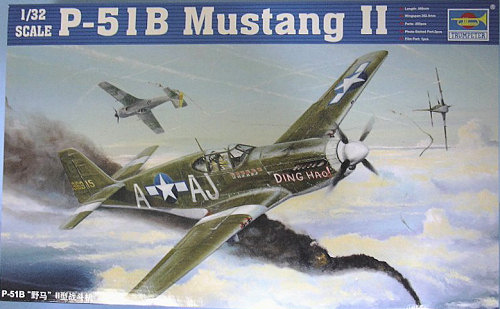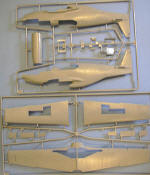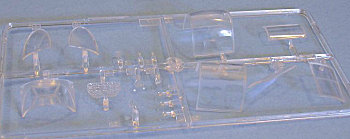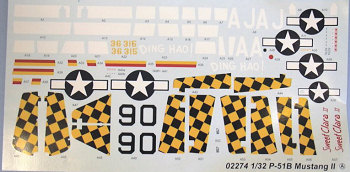
Trumpeter 1/32 P-51B Mustang
| KIT: | Trumpeter 1/32 P-51B Mustang |
| KIT #: | 2274 |
| PRICE: | $94.00 MSRP |
| DECALS: | Twooptions |
| REVIEWER: | Tom Cleaver |
| NOTES: | Small photo etch fret included. |

| HISTORY |
Everyone "knows" that the Mustang was the airplane designed and built in 120 days for the British because North American's Dutch Kindelberger didn't want to build Curtiss P-40s under license, and that the first Mustangs were a disappointment because they were hobbled by the godawful Allison engine, and that the airplane only became "good" when it was powered by the mighty Merlin. Right? That's the stuff in all the Mustang books, isn't it?
Well, yes, all that is in the "history books," many of which are written by people who prove the old saw that if you copy from one it's plagiarism, while if you copy from many it's research; and if the many have copied from each other, mistakes indeed become "facts." We are only now, sixty-odd years after the events, starting to discover that a lot of what was written as history at the outset was "uninformed" to be generous, and then was copied by those who followed, to the point that it became "the truth" because it had been repeated so many times.
Here's a truth from the horse's mouth about the origins of the Mustang: in 1981, Edgar Schmued, designer of the Mustang, came out to Chino for a 40th Anniversary celebration of his most famous work at The Air Museum, "Planes of Fame." Mr. Schmued began his career at the Bayerische Flugzeug Werke in Munich in 1934, and left in late 1937 when certain political idiots started investigating aspects of his family history. (Thank God, if World War II had to be fought, we got to fight the far right morons of the Nazi Party.) As a young engineer, Schmued had been involved in most of the detail design work that went into the creation of the Bf-109. "I was working on a fighter design of my own all that time, refining it with new information, waiting for an opportunity," he said. "Yes, the Mustang was built in 120 days, but I had been designing it for five years."
Furthermore, Dutch Kindelberger knew about Schmued's filing cabinet full of drawings, and had a strong hunch they had a pretty good design, at the time he turned down the British offer to fund North American's license production of the P-40, an airplane Kindelberger correctly saw as being at the end of its development cycle. It might have been a fight to turn the drawings into blueprints and the blueprints into a metal airplane inside 120 days, but North American was not starting with "clean paper" as everyone has believed all these years since.
While the Allison-powered Mustang was a world-beater at low altitude, the design really came into its own and became the best piston-engine fighter of the Second World War when the RAF tested three Mustang I airframes fitted with the Merlin engine, which North American then refined into what became the P-51B. Putting the best airframe available together with the best engine available created an airplane that swept through the opposition like a scythe wherever it was deployed. When the first merlin-powered Mustangs appeared over Berlin on march 6, 1944, Hermann Goering later testified at Nuremberg that “I knew the jig was up.”
| THE KIT |
 Revell released a 1/32 P-51B thirty-some years ago that has been in and out of
production over the years and of which the less said, the better; the model is
unfixably wrong for those who worry about such minor points as overall shape
accuracy and such. Jerry Rutman released a P-51B all-resin kit that is still
available and is still the most accurate P-51 in 1/32. 21st Century
Toys has announced the release of a 1/32 P-51B in their line of inexpensive
“kits” derived from their more widely-released pre-painted, pre-assembled toys,
which looks to be as good quality-wise as their Macchi C.202 and Messerschmitt
Bf-109 kits, with what is promised to be an excellent and wide-ranging decal
sheet.
Revell released a 1/32 P-51B thirty-some years ago that has been in and out of
production over the years and of which the less said, the better; the model is
unfixably wrong for those who worry about such minor points as overall shape
accuracy and such. Jerry Rutman released a P-51B all-resin kit that is still
available and is still the most accurate P-51 in 1/32. 21st Century
Toys has announced the release of a 1/32 P-51B in their line of inexpensive
“kits” derived from their more widely-released pre-painted, pre-assembled toys,
which looks to be as good quality-wise as their Macchi C.202 and Messerschmitt
Bf-109 kits, with what is promised to be an excellent and wide-ranging decal
sheet.
When I first heard Trumpeter’s announcement that they would release a 1/32 P-51B, my first thought was I hoped they didn’t pantograph down their hopelessly-mangled P-51D as the basis of the new kit. When test shot pictures appeared at IPMS Philippines, that fear was set to rest with the revelation this was a completely new-mold design. Rumblings were heard, however, among those “Mustang fanatics” that the kit had its share of problems. Having just completed both the excellent P-47 Thunderbolt and the “lacking” F6F-5 Hellcat, I was hoping for something closer to the P-47 when I opened the big sturdy Trumpeter box and took a look inside.
What I found was, sadly, closer to the Hellcat.
The Good:
The overall shape accuracy of the kit is good, among the best of any P-51 kit on the market. The coffin-lid canopy is right. The prop blades are right (a big plus when compared to the 1/32 P-51 kit from another Chinese manufacturer that I failed to review a year ago after trashing it). The 75-gallon metal tanks and 108-gallon paper tanks (which come from the P-47 kit) are good. The rivet/divot surface detail is not so annoying that it won’t look acceptable under paint, as proved to be the case with the P-47 and the Me-262 kits. The photo-etch seatbelts reveal that Trumpeter bought some of Eduard’s new 1/32 seat belts, studied them closely and made a “Chinese copy” - a good idea.
The Bad:
The
overall problem with the kit is that Trumpeter couldn’t decide if they were
doing a P-51B or a P-51D - given that they are soon to release a P-51D, it is
obvious they wanted to have as much commonality of parts as possible.
Unfortunately, they did not get the fact that many of the details of a P-5 1B
are completely unlike a P-51D and cannot be made common no matter how hard one
tries, at least not if accuracy of the kit is any criteria in the design.
1B
are completely unlike a P-51D and cannot be made common no matter how hard one
tries, at least not if accuracy of the kit is any criteria in the design.
The gear wells are the usual mythological creation that dogs all P-51 kits in any scale other than Jerry Rutman’s P-51B. The rear “wall” of the outer gear well does not follow the forward sweep of the gear opening, as it does here. In 1/32 scale, the way Trumpeter has molded this area, a modeler who wants to correct this can do it with a minimum of hassle with Evergreen sheet. More problematic is the fact that the main gear wheel doors are just “off” in shape, and that the outer doors are P-51D doors - which are noticeably wider in chord than the doors of the P-51B and the Allison Mustangs. Additionally, these doors are “off” in overall shape in a way not easily fixed without some Evergreen sheet and modification of the gear well opening in the wing along with straightening the rear spar. Most people likely won’t worry about this, but the modeler who thinks of the P-51 the way other modelers think of the Bf-109, the Fw-190 or the Spitfire, is going to be “miffed” to say the least.
The kit has the formation lights in the outer right wing that is correct for a P-51D and wrong for a P-51B. This can be fixed with an application of Mr. Surfacer, a few minutes with a sanding stick, and a pounce wheel to put in the rivets in that area.
There are no shell ejection chutes for the wing guns. This is something easily fixed with a #11 X-acto and “some modeling skill required” along with a small modeling file, but it still seems strange that this would be missed.
The exhaust stacks are single pieces, and do not include the cover commonly used on the majority of Mustangs. The modeler will have to at least assemble the basic engine and mounts, to have something to attach the exhaust stacks to. The only way to get the other kind of exhausts would be to rob a Dragon kit (one could trade stacks I suppose).
The wings are not a laminar cross-section, which most people will not notice, but some will look at the final result and wonder why it is that the upper wing/fuselage joint looks “off” to them.
Like most Trumpeter kits, this one is over-engineered, with lots of parts that will end up staying in the box since they depict areas of the model that can’t be seen without cutting the model open. However, those who want to do that kind of model will be happy with the basic materials provided here to start that kind of project.
The Ugly:
 The decals suck. They are
worthless (unless one lives in a town that doesn’t have 24-hour stores and
happens to run out of a certain valuable paper product in the bathroom in the
middle of the night). Once again, Trumpeter seems to find it impossible to get
the proportions right on U.S. National Insignia. The font and colors of “Ding
Hao!” and the scoreboard for this airplane are wrong. The tail checkerboard
decals for the other option reveal that Trumpeter failed to take a look at any
photograph of a 325th FG “Checkertail” to see how the checkers were
applied, and as a result has these completely wrong. The good news here is that
there are previously-released 1/32 P-51B decals from SuperScale, Aeromaster and
CAM (which did a perfect sheet for “Ding Hao!”) that can be found at collector’s
tables and will likely be re-released. There is also that 21st
Century Toys sheet out there.
The decals suck. They are
worthless (unless one lives in a town that doesn’t have 24-hour stores and
happens to run out of a certain valuable paper product in the bathroom in the
middle of the night). Once again, Trumpeter seems to find it impossible to get
the proportions right on U.S. National Insignia. The font and colors of “Ding
Hao!” and the scoreboard for this airplane are wrong. The tail checkerboard
decals for the other option reveal that Trumpeter failed to take a look at any
photograph of a 325th FG “Checkertail” to see how the checkers were
applied, and as a result has these completely wrong. The good news here is that
there are previously-released 1/32 P-51B decals from SuperScale, Aeromaster and
CAM (which did a perfect sheet for “Ding Hao!”) that can be found at collector’s
tables and will likely be re-released. There is also that 21st
Century Toys sheet out there.
The cockpit bears no relationship to any cockpit in any Mustang of any sub-type, ever. The instrument panel is a P-51D panel by shape, with an insert that tries to put the individual instruments in a “P-51B-like pattern.” The seat and the armor backing are bastardizations of a P-51D seat and armor. The side panels are for the P-51D, with a few that never existed on any P-51 thrown in for good measure. The floor is curved, like the Allison-Mustang floor (and looks to be the floor that will be in the P-51D, given the P-51D side panels). The kit also offers the option of a British “spade grip” control stick which no Mustang ever used.
But the piece de resistance is a “rear bulkhead” just behind the seat that COMPLETELY cuts off the cockpit from the rear area with the tank and the scalloped rear windows. Where this bit of fantasy came from I have no idea.
The “Malcolm Hood” the kit provides looks like the original only in side profile, since it is not “blown” in any way.
The only good news I can see here immediately is that Jerry Rutman might take pity on modelers and sell the cockpit parts for his very good kit, which would give an accurate P-51B cockpit - which is the most vital part of the model and the area in the most need of rescuing. Other aftermarket companies will also likely ride to the rescue here.
| CONCLUSIONS |
I did manage to resist the urge to close the box, take it out in the back yard, pretend it was a soccer ball and “bend it like Beckham.” Unlike the Dragon collection of scrap plastic in a box masquerading as a P-51 kit, most of what is wrong here can be fixed, and is not so crucial that less-demanding modelers won’t have models in their collection they’re unhappy with - provided they get an aftermarket decal sheet. The coming 21st Century Toys kit will be modestly priced to the point it can be viewed as a collection of alternative parts and decals to get this kit right.
But coming after the very nice P-47 and F-100, and arriving in the same shipping box with the very, very nice Me-262B-1a kit (that’s another review) - a comparison was easily invited between “got it right” and “close, but no cigar” - the kit registers as an overall disappointment. It won’t be in the “to do” pile until I can get a good resin cockpit and a worthwhile set of decals.
As with the P-51D, the modeling world still awaits a really good P-51B in 1/32 scale for the average modeler to feel comfortable doing - though Jerry Rutman’s P-51B is very good and completely competitive price-wise with this kit, for the modeler unafraid of attempting a full-resin short-run kit.
Bottom line: you can, with effort, create a nice model from this kit. But - for $94 - you should be able to create a nicer one.
Thanks to Stevens International for the review copy.
January 2008
If you would like your product reviewed fairly and quickly, please contact me or see other details in the Note to Contributors.